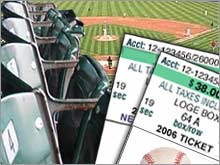Baseball's flatter playing field Big-dollar teams may end up winning this year's playoffs. But the game's salary structure is more like the NFL than you think. NEW YORK (CNNMoney.com) -- Baseball's playoffs would seem to be a good argument both for and against a more level financial playing field in baseball. Of the eight teams knocking heads in playoffs this week, three are among the top six spending teams and are based in the nation's two biggest markets: New York's Yankees and Mets and the Los Angeles Dodgers.
The other free-spending teams were in the postseason hunt until late into the season, as the big-market Boston Red Sox, Los Angeles Angels of Anaheim and defending champion Chicago White Sox round out the top six spenders. Most of the low-revenue, low-payroll teams, like the Kansas City Royals, Tampa Bay Devil Rays and Pittsburgh Pirates, were out of contention well before Memorial Day. But the Florida Marlins, saddled with a $14.5 million team payroll (less than many star player's individual salaries), stayed in contention through mid-September. However, the postseason this year also includes four low-revenue teams that are there by the grace of smart management and a boost from their competitors' wallets. The Oakland Athletics, the Minnesota Twins, the Detroit Tigers and, to some extent, the San Diego Padres all received critical millions in revenue-sharing money at the end of last year as they were putting together this year's contending clubs. The Tigers got $25 million in revenue sharing at the end of last year, according to BizofBaseball.com, helping them add some of the veteran players they needed to balance the young pitching staff that got them to their first playoffs since 1987. The Twins got $22 million and the Athletics, $19 million, while the Padres received slightly less than $6 million. Overall more than $300 million passed from baseball's haves to its have-nots. And that doesn't count more than $100 million more that the Yankees and Red Sox paid in a so-called luxury tax on their payrolls. The results of the full season show that the impact of big dollars is being mitigated by better baseball management and by the changes in the league structure that are spreading the dollars around much more evenly than before, giving teams more incentive to compete. New broadcasting deals with Walt Disney (Charts) unit ESPN, cable network TBS (which like CNNMoney.com is a unit of Time Warner (Charts)) and News Corp.'s (Charts) Fox, in addition to new money from sources such as XM Satellite Radio (Charts) and MLB.com, have poured millions into the game that is spread evenly between the 30 teams. The wild-card system has kept more teams competitive and spending on players for a shot at a playoff spot. Almost the entire National League was in contention for a playoff spot deep into September, thanks mostly to the wild card. In fact the Philadelphia Phillies, a team that in July traded two of its stars to the deep-pocket Yankees in an effort to cut payroll, soon found themselves in the wild-card hunt and trading for well-paid veteran stars. "It seems like everybody is spending money," said Maury Brown, editor of BizofBaseball.com. "People understood more revenues were coming in. And I think that the wild card, more than anything, has been the key to getting a lot of teams in the spending mode. They realize it creates at least the artificial sense of a pennant chase." How flat is the playing field? One of the best measures of competitive balance is to look at how far each team in the majors is from the median team payroll. This is best measured by a something known as standard deviation, a statistic that might sound scary but should be easy to understand to fans used to comparing more exotic stats like ERA or OPS. With a totally flat playing field, everyone would be at the median salary, and the standard deviation would be zero. At the other extreme, where half the teams have a payroll equal to the Yankees and the other half a payroll equal to the Marlins, the standard deviation would be about half the difference between those two poles. So the smaller the standard deviation, the more level the financial playing field. The standard deviation in baseball payrolls fell 5.7 percent between 2005 and this season, the first year-over-year tightening in team payrolls since 1994. In 2005, the standard deviation was up only 5.1 percent, after gains of 11.8 percent and 17.8 percent in 2003 and 2004. That means that the Oakland Athletics, the team that was the poster child for success above its income bracket in Michael Lewis's 2003 book "Moneyball," are no longer doing it with brains alone. The team had a payroll more than one-third below the majors' median salary level in 2002, the year that Lewis followed the team and the new collective bargaining agreement was negotiated. This year it was only 14 percent below the league minimum. Lewis, while watching the Athletics win the first game of the playoffs at a New York sports bar this week, said that teams like the Athletics can no longer find enough players who are undervalued by the market in order to put together a winning team, the way they did when he followed the team in 2002. That's largely because management offices of other teams are getting smarter about how they value players. And it's also because the A's have more money to spend. "Over time, in order to be competitive, they have to spend more money because the inefficiencies in the marketplace are drying up," he said. Yes, the Yankees have a payroll that dwarfs any other team and allows them to bat an All-Star at every position in this year's playoffs. But if proof is needed that baseball's financial playing field is even flatter than the National Football League, where parity is state religion with its hard cap on team payrolls and even greater sharing of revenue, consider this: The Yankees are done, victims of the Tigers in the first round of the American League Championship Series. Progress seen in baseball labor talks |
| |||||||||||||||||




